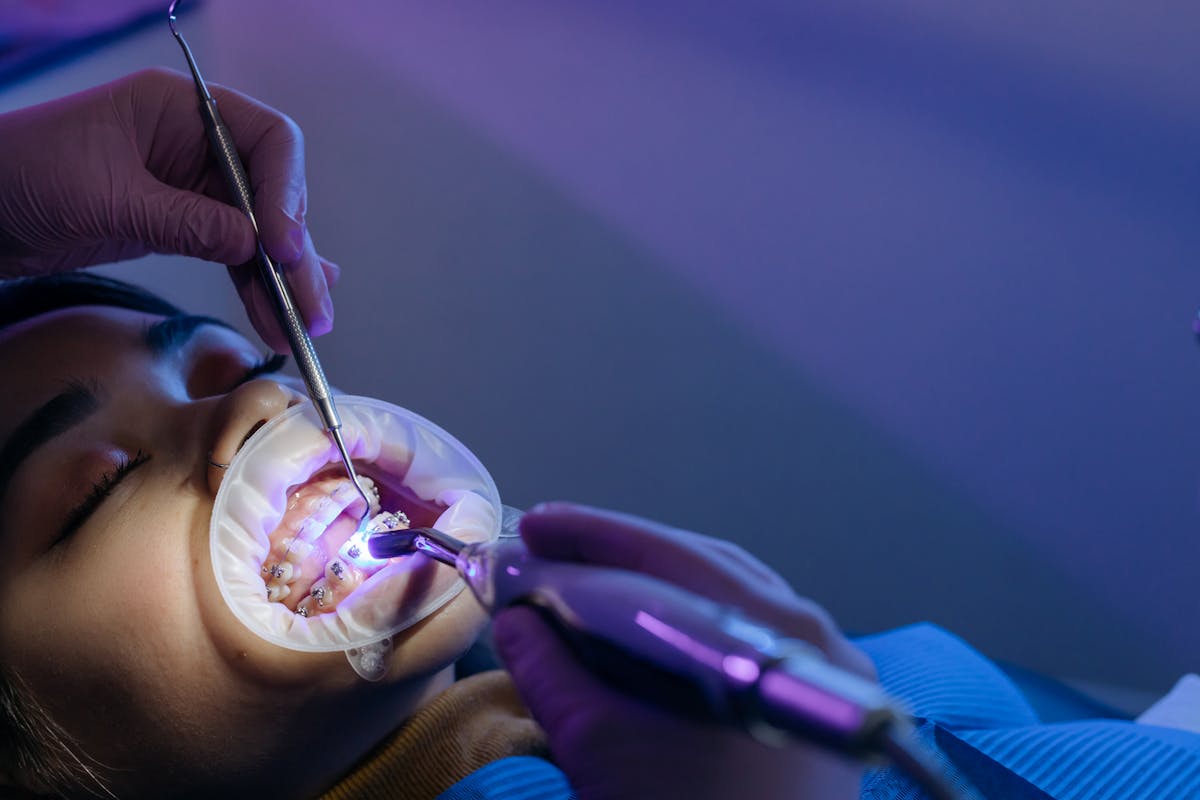The journey to a perfect smile doesn’t end when braces are removed; it extends to the consistent use of retainers. These unassuming appliances play an essential role in maintaining the alignment achieved through orthodontic treatment, effectively safeguarding your smile investment. Yet, retainers also require a level of care and attention to guarantee they continue serving their purpose effectively. How can a simple routine of cleaning and proper storage contribute to the longevity of your retainer, and subsequently, the lifespan of your smile? Let’s explore this often overlooked but vital phase of orthodontic aftercare.
Understanding the Role of Retainers
Retainers play an essential role in maintaining the new alignment of your teeth after the removal of braces. They are custom-made devices, usually made of wires or clear plastic, designed to hold teeth in their corrected positions. There are various retainer types available, each with distinct advantages depending on an individual’s needs and lifestyle. These types include removable retainers such as Hawley and Essix, as well as fixed retainers. The retention duration, or how long one should wear a retainer, is generally a lifelong commitment. However, the specific time frame may vary based on the orthodontist’s recommendation. It’s vital to adhere to this guideline to guarantee the stability of your teeth’s new positioning.
Why Retainers Are Necessary Post-Braces
Having explored the role of retainers and their importance in sustaining the new alignment of teeth, it is now necessary to examine why these devices are essential after the removal of braces. The retainer’s importance lies in its ability to maintain the post braces adjustments. After braces, teeth tend to shift back to their original positions, a phenomenon known as relapse. This is due to the elastic memory of the periodontal fibres surrounding the teeth. Retainers, consequently, are vital in holding the teeth in their new positions until the fibres adjust to the changes. Neglecting to wear a retainer post-braces can lead to misalignment, undoing the time, effort, and financial investment put into the braces treatment.
Different Types of Retainers
Following the necessity of retainers post-braces, it is essential to understand the different types available to maintain orthodontic progress. This segment will elucidate the characteristics of removable and permanent retainers, each with its own set of advantages and considerations. Subsequently, we will provide guidance on how to select the most suitable retainer type, tailored to individual needs and lifestyle.
Understanding Removable Retainers
While many are familiar with the role of braces in orthodontics, it is perhaps less well-known that removable retainers play an equally important part in maintaining a newly-straightened smile. These devices are custom-made to fit your mouth post-braces, providing several benefits. Removable retainer benefits include the ability to clean your teeth thoroughly, as you can take the retainer out during oral hygiene routines. This flexibility also allows for easier eating and speaking. However, removable retainer care is essential. Regular cleaning of the retainer is necessary to prevent bacteria build-up and damage. Proper storage when not in use is also critical, reducing the risk of loss or breakage. Understanding and following these care instructions guarantee your smile remains perfect post-braces.
Permanent Retainers Explained
In contrast to removable retainers, permanent retainers offer a long-term solution for maintaining the alignment of your teeth post-braces. These devices are typically made of a thin wire bonded to the back of your teeth, offering several permanent retainer benefits. To begin with, they guarantee your teeth remain in their corrected position, helping to maintain your newly achieved smile. In addition, their fixed nature eliminates the risk of misplacing them, a common problem with removable alternatives. Permanent retainers also allow for uninhibited speech and are virtually invisible. However, permanent retainer care is essential; diligent cleaning practices must be maintained to prevent plaque build-up. Ultimately, permanent retainers provide a dependable, low-maintenance solution to preserve your perfect smile.
Choosing the Right Retainer
How do you choose the right retainer for your individual circumstances and needs? The answer largely depends on two factors: retainer materials and lifestyle considerations. Retainer materials vary—from acrylic and wire to clear plastic—each with differing levels of durability, comfort, and visibility. Your Orthodontist in Manhattan NY can provide detailed insights into these materials to help you make an informed decision. Lifestyle considerations are also essential. If you’re active in sports, a sturdy, durable retainer might be recommended. If appearance is a concern, a clear, unobtrusive retainer could be a better fit. Ultimately, the choice of a retainer should balance practicality with comfort, ensuring your smile remains as perfect as the day your braces came off.
How to Wear Your Retainer
Guaranteeing the correct use of your retainer plays a vital role in maintaining the alignment of your teeth post-orthodontic treatment. Wearing your retainer properly requires integrating it into your daily routine and adhering strictly to guidelines provided by your orthodontist.
Retainer adjustments are essential to confirm its effectiveness. Never adjust the retainer yourself; always consult your orthodontist for proper adjustments. This guarantees the retainer fits snugly and comfortably, facilitating its purpose.
Incorporating the retainer into your daily routine might seem intimidating initially but becomes second nature over time. Wear it for the prescribed hours, typically overnight, and never forget to put it on after removing it for meals. Consistent use is essential to prevent teeth from reverting to their initial position.
Cleaning and Storing Retainers
Proper care and maintenance of your retainer is a significant aspect of post-orthodontic treatment, which includes regular retainer cleaning and appropriate storage. To maintain its effectiveness and prolong its lifespan, cleaning should be done daily with a soft-bristled toothbrush, using lukewarm water and mild soap. Avoid using harsh chemicals or hot water, as they can damage the retainer.
Proper storage is equally important to prevent damage and loss. When not in use, the retainer should be kept in a designated, hard-shell case. This will protect it from physical damage and contamination. Avoid exposing the retainer to heat or direct sunlight, as it can warp the plastic. With these simple steps, you can guarantee your retainer remains functional for a longer time.
Overcoming Common Retainer Problems
While diligent care can prevent many issues, wearers may still encounter some common retainer problems. The most prevalent among these is retainer discomfort, particularly in the initial period of usage. This discomfort is typically caused by the pressure exerted on the teeth as they adjust to the retainer. However, adjusting expectations can lessen feelings of discomfort. Understanding that some unease is natural and temporary can help wearers persevere through the initial adjustment phase. Additionally, regular communication with an orthodontist can guarantee any discomfort is not a sign of ill-fitting retainers. They can rectify issues swiftly, thereby preventing any long-term impact on oral health. Overcoming problems is integral to maintaining your smile post-braces.

Signs of Poor Retainer Maintenance
Neglecting retainer maintenance can manifest in several noticeable ways. Poor hygiene, for instance, can lead to discoloration issues, a clear sign of improper care. Missed appointments with your orthodontist can also contribute to poor maintenance, as these visits are essential for evaluating the retainer’s condition and fit. Discomfort signs, like pain or difficulty speaking, may indicate a poorly maintained or broken retainer. Broken retainers are often a result of improper storage or handling, and can compromise the effectiveness of your orthodontic treatment. It’s important to store retainers correctly when not in use to prevent damage. Recognizing these signs early can help you maintain your retainer well and preserve your smile.
Success Stories: Retainers Preserving Smiles
Highlighting the efficacy of retainers, we turn our attention towards compelling success stories that underscore the significance of post-braces care. These narratives offer profound insights into the journey of individuals who have experienced significant transformations, thanks to their commitment to retainer use. In an effort to underscore the crucial role retainers play in maintaining that perfect post-braces smile, we will explore real-life experiences and the impact of retainers on long-term dental health.
Real-life Retainer Experiences
Countless individuals worldwide have proven the efficacy of retainers in maintaining their perfect smiles post-braces. These real-life retainer experiences are not just clinical anecdotes but are personal stories of triumph over dental misalignment. Many patients, initially skeptical, have reported that diligent retainer use has preserved the alignment achieved through braces, reinforcing the importance of this orthodontic device. A young woman, for instance, detailed how her retainer helped maintain her smile even five years after her braces were removed. Another man shared his experience of forgetting his retainer for a few weeks, only to witness a noticeable shift in his teeth. These stories collectively underscore the necessity of retainers in maintaining orthodontic progress and preserving that hard-earned smile.
Post-Braces Smile Preservation
While it might seem trivial to some, the preservation of a post-braces smile plays a pivotal role in a person’s self-esteem and confidence. Post braces care is essential for smile longevity and overall dental health. A remarkable success story of this is Rachel, who has maintained her radiant smile for over a decade post orthodontic treatment. Her secret? Commitment to wearing her retainer diligently, thereby preserving the alignment and aesthetics achieved through braces. Similarly, Michael’s unwavering discipline in his post braces care routine guaranteed his smile remained as vibrant as the day his braces came off. These success stories highlight the intrinsic link between retainers and smile longevity, embodying the crux of smile preservation post-braces.
Significant Retainer Transformations
Numerous compelling stories demonstrate the transformative power of retainers in maintaining the perfection of a post-braces smile. One such example is of a young woman whose teeth had severely shifted post-braces. Through careful retainer adjustments, her orthodontist was able to restore her smile back to its former glory.
Another case features a middle-aged man who credited his retainer for his smile longevity, even after two decades. Despite minor teeth movements, his retainer helped retain the alignment of his teeth, preserving his radiant smile.
These cases underline the significant role of retainers in preserving dental alignment post-braces. They showcase the substantial transformations possible with consistent use and regular retainer adjustments, contributing to lifetime smile perfection.
Frequently Asked Questions
Can I Eat Food While Wearing My Retainer?
No, eating food while wearing your retainer is not recommended. It can damage the retainer and impact its effectiveness. Proper retainer care includes removing it during meals to maintain both ideal oral health and eating habits.
Will I Need to Replace My Retainer Over Time?
Yes, retainers typically require replacement over time due to wear and tear. The retainer lifespan varies based on factors like material quality and care. Regular consultations with an orthodontist will determine the replacement frequency.
Does Health Insurance Typically Cover the Cost of Retainers?
Coverage for retainer types varies widely among health insurance policies. It’s crucial to check with your insurance provider to understand what orthodontic treatments, including retainers, are covered under your specific plan.
Can Retainers Correct Teeth Alignment Without Braces?
While retainers maintain alignment post-braces, their effectiveness in correcting alignment issues without prior orthodontic treatment is limited. They can make minor adjustments, but severe misalignments typically require braces or other orthodontic interventions.
What Are the Consequences of Not Wearing My Retainer as Recommended?
Neglecting recommended retainer usage can lead to teeth shifting back into misaligned positions, reversing orthodontic progress. Additionally, improper retainer use could potentially impact oral hygiene, leading to a variety of dental health issues.
